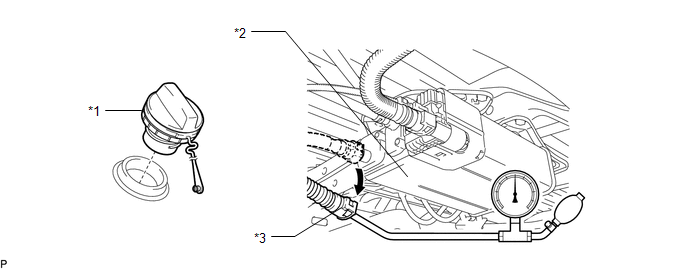ON-VEHICLE INSPECTION PROCEDURE 1. INSPECT FUEL CUT-OFF OPERATION (a) Start and warm up the engine. (b) Open the throttle valve and keep the engine speed at 3000 rpm. (c) Use a sound scope to check for injector operating noise. (d) Check that when the accelerator pedal is released, injector operation noise stops momentarily and then resumes. If the result is as not specified, check the injector, wiring and ECM. 2. VISUALLY INSPECT HOSES, CONNECTIONS AND GASKETS (a) Check that there are no cracks, leaks or damage. HINT: Separation of the engine oil dipstick, oil filler cap, ventilation hose, etc. may cause an engine failure or engine malfunctions. Disconnection, looseness or cracks in the parts of the air induction system between the throttle body and cylinder head will allow air suction and cause an engine failure or engine malfunctions. NOTICE:
If the result is not as specified, replace parts as necessary. 3. INSPECT FUEL CUT-OFF VALVE AND FILL CHECK VALVE (a) Disconnect the vent line hose from the charcoal canister.  Text in Illustration Text in Illustration
(b) Connect a pressure gauge to the vent line hose. (c) Fill the fuel tank with fuel. (d) Apply a pressure of 4 kPa (41 gf/cm2, 0.6 psi) to the vent port of the fuel tank. HINT: When the fuel tank is full, the float valve of the fill check valve is closed and there is no ventilation. Therefore, it is necessary to check the fuel amount. (e) Remove the fuel tank cap and check that the pressure inside the tank drops. If the pressure does not drop, replace the fuel tank assembly. (f) Reconnect the vent line hose to the charcoal canister. 4. CHECK AIR INLET LINE
(b) Check that there is ventilation in the air inlet line. If air cannot flow freely into the air inlet line, repair or replace the air inlet line. (c) Reconnect the air inlet line hose to the charcoal canister. 5. INSPECT SECONDARY AIR INJECTION SYSTEM OPERATION (a) Start the engine and warm it up. (b) Turn the ignition switch off. (c) Connect the Techstream to the DLC3. (d) Turn the ignition switch to ON and turn the Techstream on. (e) Enter the following menus: Powertrain / Engine and ECT / Utility / Secondary Air Injection Check / Manual Mode / AIR PUMP 1: ON, ASV1: OPEN, AIR PUMP 2: ON, ASV2: OPEN and AIR PUMP 1: OFF, ASV1: CLOSE, AIR PUMP 2: OFF, ASV2: CLOSE. HINT: When Manual Mode is selected, the Techstream initialization (atmospheric pressure measurement) is performed automatically. The initialization takes 10 seconds. After the initialization, AIR PUMP and ASV operation can be selected. (f) Start the engine. (g) Perform the AIR system intrusive operation while the engine is idling. (h) Check that the air pump (AIR PUMP), ASV and pressure in the AIR system passage (PRESSURE) status displayed on the Techstream indicate the conditions shown in the table below. Standard:
*1: Average pumping pressure (gauge pressure). The pressure should be 1.9 kPa or more when the AIR system operates. *2: The cumulative exhaust pulsation calculated by the ECM. If the calculated value exceeds a certain level, the ECM determines that the exhaust pulsation is in the AIR system. (i) Turn the ignition switch to off. NOTICE:
|
Toyota Tundra Service Manual > Seat Belt Warning System: Terminals Of Ecu
TERMINALS OF ECU 1. CHECK COMBINATION METER ASSEMBLY (a) Disconnect the J28 combination meter assembly connector. (b) Disconnect the J28 combination meter assembly connector. (c) Measure the resistance and voltage according to the value(s) in the table below. Terminal No. (Symbol) Wiring Color Termi ...